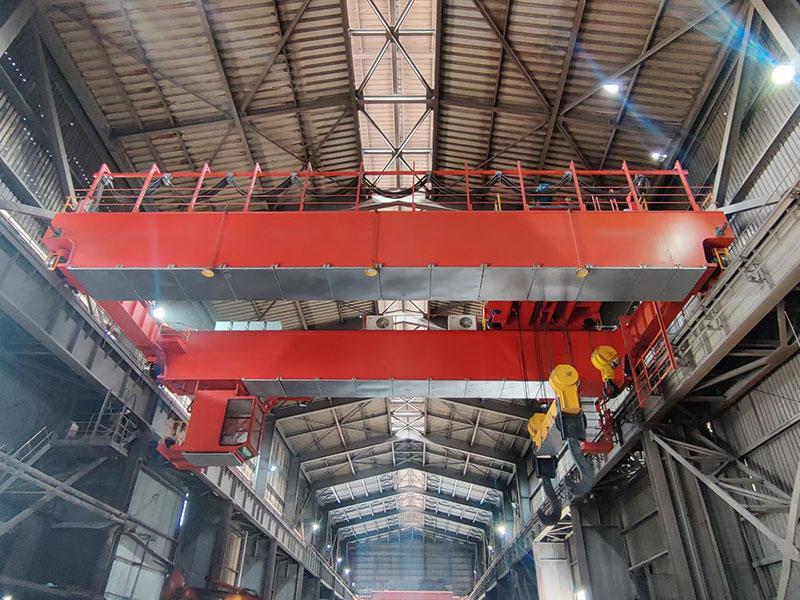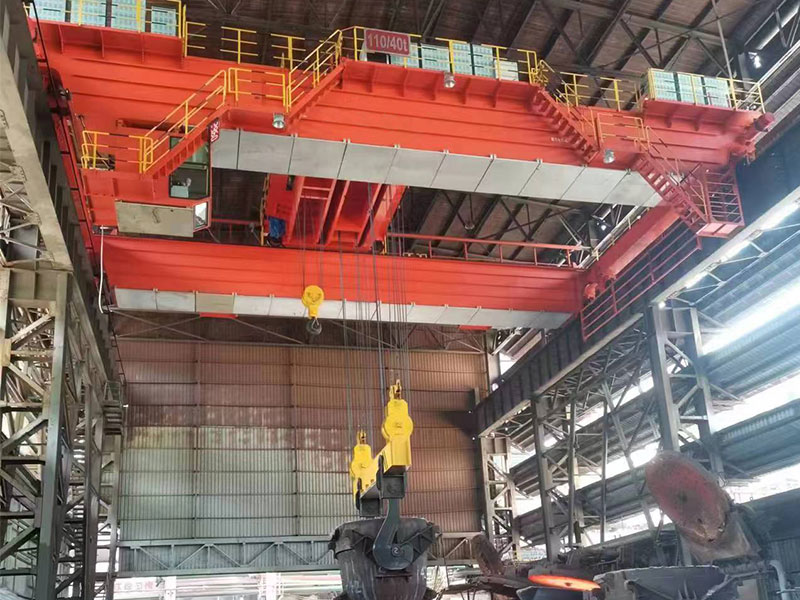In the world of heavy lifting, foundry cranes play an essential role in safely transporting molten metals, heavy castings, and other materials in high-temperature environments. At the heart of a foundry crane’s lifting mechanism is the crane hook, a key component designed to handle substantial loads under extreme conditions. The foundry crane hook is not only responsible for bearing heavy weights but also ensuring safety during operations.
This article explores the various types of foundry crane hooks, their functions, and, most importantly, the safety features that are critical to ensuring safe operation in a foundry environment.

1. Understanding Foundry Crane Hooks
A crane hook is typically a steel or alloy steel device that connects the load to the crane’s hoist system. In a foundry setting, where molten metal and heavy materials are transported in hazardous environments, the hook must be exceptionally robust, durable, and resistant to extreme conditions such as high heat, heavy weight, and abrasive substances.
Foundry crane hooks are designed to handle diverse materials, including molten metals, casting molds, and heavy machinery components. The hook must provide a secure connection and withstand significant dynamic and static loads without failure.
2. Types of Foundry Crane Hooks
The choice of a crane hook depends on various factors, including the nature of the load, the weight of the material being lifted, and the specific environment in which the crane operates. Below are the common types of foundry crane hooks:
2.1 Single Hook
The single hook is the most common type of steel mill crane hook. It is used for lifting various loads, including heavy machinery, equipment, and materials in the foundry. The single hook is easy to maintain and suitable for moderate to heavy lifting applications.
-
Applications: Lifting molten metal pots, lifting heavy equipment, and moving molds.
-
Key Features: Simple design, ease of operation, and suitability for light-to-medium weight loads.
2.2 Double Hook
The double hook is a more complex design, with two hooks to balance the load more evenly. This is particularly useful for lifting asymmetric or oversized loads that might not be safely handled by a single hook. A double hook provides more stability during lifting and is often used in applications requiring precise and careful handling.
-
Applications: Lifting large, irregularly shaped loads, transporting heavy casting molds.
-
Key Features: Higher stability, reduced load shift, and greater safety for large or unstable loads.
2.3 Crab Hook
A crab hook, also known as an overhead hook, is often used for lifting heavy materials in tandem with a hoist or overhead lifting system. These hooks are equipped with a special attachment that helps balance and stabilize the load, making them ideal for the harsh environments of a foundry.
-
Applications: Lifting and transporting molten metal ladles, heavy castings, or large industrial components.
-
Key Features: Strong, durable, and designed for high heat resistance.

2.4 Swivel Hook
Swivel hooks are designed to rotate freely under load, providing greater flexibility and ease of maneuverability when lifting and positioning loads. These hooks are ideal for applications that require precise load positioning and smooth movement.
-
Applications: Used in foundries where loads need to be moved horizontally and positioned accurately before being lowered or placed.
-
Key Features: 360-degree rotation, reduces stress on load during rotation, and enhances load control.
2.5 Foundry Hooks with Heat Resistance
Foundry crane hooks are often made with heat-resistant alloys such as alloy steel or heat-treated steel to withstand high temperatures typically found in a foundry. These hooks are designed to handle high-temperature applications, including molten metal handling.
-
Applications: Handling molten metals, transporting hot castings, and moving heavy metal components in high-heat environments.
-
Key Features: High-temperature resistance, increased durability under extreme conditions, and long-lasting performance in hot environments.
3. Safety Features of Foundry Crane Hooks
The safety of personnel and equipment is paramount when working in a foundry environment. The heavy duty overhead crane hooks, which often carry heavy loads in hazardous environments, must be equipped with several safety features to ensure that both the operator and the load remain safe during lifting operations.
3.1 Load Testing and Certification
A crucial safety feature for any crane hook is load testing and certification. The hooks should undergo rigorous testing to ensure that they can safely handle loads up to their rated capacity. Certification ensures that the hooks are compliant with safety regulations and capable of performing under extreme conditions.
-
Best Practices: The crane hook should be periodically tested to ensure that it remains in safe working condition. The hook’s certification must be up-to-date, and the load-bearing capacity must be clearly marked for reference.
3.2 Anti-Sway and Anti-Twist Features
A common risk during lifting operations is the twisting or swaying of the load. This can be particularly dangerous in foundry settings where the load may be extremely hot or fragile. Crane hooks can be equipped with anti-sway and anti-twist mechanisms to minimize such risks.
-
Anti-Sway: Prevents the load from swaying uncontrollably during lifting. This is especially important for the transport of molten metal ladles or other materials that could spill or cause an accident if not secured.
-
Anti-Twist: Prevents the hook from twisting under heavy loads, ensuring that the load remains stable and secure during transport.
3.3 Latch Mechanism
Foundry crane hooks are often equipped with a latch mechanism that secures the load and prevents it from falling or slipping off the hook during lifting. The latch can either be manually operated or automatic, depending on the application and safety requirements.
-
Safety: The latch ensures that the load remains securely attached to the hook, preventing accidental drops that could harm personnel or damage equipment.
3.4 Thermal Insulation
For foundry environments where ladle cranes are used to lift molten metal, a hook with thermal insulation can provide an added layer of safety. Thermal insulation helps protect the crane hook from the heat generated by the molten metal, reducing the risk of metal fatigue, deformation, or failure due to excessive heat.
-
Functionality: Insulated hooks prevent temperature-induced damage to both the crane and the load, ensuring consistent performance under high-heat conditions.
3.5 Strength and Durability
One of the most critical safety features of any foundry crane hook is its strength and durability. The hook should be made from high-strength steel alloys that can withstand heavy lifting, impact loads, and high temperatures.
-
Material Selection: High-quality alloy steel, heat-treated steel, or other durable materials are often used to manufacture crane hooks to ensure long-lasting performance.
-
Design Considerations: A properly designed hook will ensure that stress is evenly distributed across the load and the hook itself, preventing breakage or failure during operation.
3.6 Inspection and Maintenance Protocols
Routine inspection and maintenance are essential safety features for foundry crane hooks. The hook should be regularly inspected for signs of wear, cracks, deformation, and other issues that could affect its strength or stability.
-
Inspection Frequency: It is essential to conduct frequent inspections of crane hooks, especially in high-stress environments like foundries.
-
Maintenance: Any damaged or worn-out hooks should be replaced immediately to avoid safety hazards during lifting operations.
4. Conclusion
Foundry crane hooks are indispensable components in the lifting and transportation of heavy and hazardous materials in foundries. From lifting molten metal to moving heavy castings, these hooks must be designed with both functionality and safety in mind.
By understanding the various types of crane hooks and their respective safety features, foundry operators can ensure that their equipment is properly chosen, used, and maintained to meet safety standards. Key safety features such as load testing, anti-sway systems, latching mechanisms, thermal insulation, and regular inspections can dramatically reduce the risks associated with crane lifting operations.
Ultimately, the safety of personnel and the efficient operation of the foundry depend on the selection of the right crane hook and the proper maintenance of the equipment. When properly maintained and used, foundry crane hooks can help ensure safe, effective, and reliable operations for years to come.
